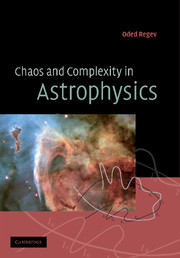Book contents
- Frontmatter
- Contents
- Preface
- Acknowledgements
- Part I Dynamical systems – general
- 1 Introduction to Part I
- 2 Astrophysical examples
- 3 Mathematical properties of dynamical systems
- 4 Properties of chaotic dynamics
- 5 Analysis of time series
- 6 Regular and irregular motion in Hamiltonian systems
- 7 Extended systems – instabilities and patterns
- Part II Astrophysical applications
- References
- Index
1 - Introduction to Part I
Published online by Cambridge University Press: 14 January 2010
- Frontmatter
- Contents
- Preface
- Acknowledgements
- Part I Dynamical systems – general
- 1 Introduction to Part I
- 2 Astrophysical examples
- 3 Mathematical properties of dynamical systems
- 4 Properties of chaotic dynamics
- 5 Analysis of time series
- 6 Regular and irregular motion in Hamiltonian systems
- 7 Extended systems – instabilities and patterns
- Part II Astrophysical applications
- References
- Index
Summary
Not chaos-like, together crushed and bruised,
But, as the world harmoniously confused:
Where order in variety we see,
And where, though all things differ, all agree.
Alexander Pope, Windsor Forest.In this part of the book we provide the basic mathematical background for dynamical systems and chaos theory. Some of the ideas introduced here will be applied to various astrophysical systems in the second part of the book. Our discussion here, while not particularly rigorous, will, however, be rather theoretical and abstract. I believe that a reasonable precision in building the basis for further understanding and research is mandatory. Throughout the discussion we continually give specific examples and often return to them in other places in the book. These examples, including some systems that are important by themselves, illustrate the various abstract concepts.
I have made an effort to interest readers, whose background is astronomy and astrophysics, by starting with astrophysical examples. After all, dynamical system theory and chaos have their origins in the studies of the three-body problem and celestial mechanics by Poincaré at the end of the nineteenth century. Fluid turbulence, an important unsolved scientific problem, is now being approached using methods from chaos and dynamical system theory. It has also had many important applications in astrophysics. Readers who are interested more in applications and less in theory and mathematical structure are particularly encouraged to become acquainted with the main concepts and results of this part of the book. Technical details may be skipped, certainly during first reading. When dealing with the second part (applications), the interested reader may return to the relevant material in the first part and study it more deeply.
- Type
- Chapter
- Information
- Chaos and Complexity in Astrophysics , pp. 3 - 7Publisher: Cambridge University PressPrint publication year: 2006



